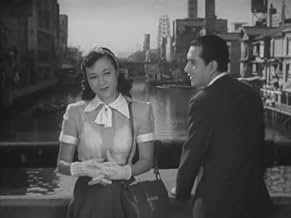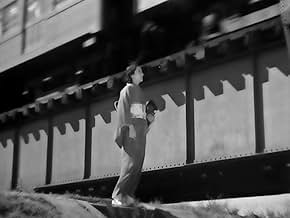Michiyo vit dans une petite maison à Osaka et n'est pas heureuse dans son mariage : tout ce qu'elle fait, c'est de cuisiner et laver le linge pour son mari.Michiyo vit dans une petite maison à Osaka et n'est pas heureuse dans son mariage : tout ce qu'elle fait, c'est de cuisiner et laver le linge pour son mari.Michiyo vit dans une petite maison à Osaka et n'est pas heureuse dans son mariage : tout ce qu'elle fait, c'est de cuisiner et laver le linge pour son mari.
- Réalisation
- Scénario
- Casting principal
- Récompenses
- 9 victoires au total
Avis à la une
There is no plot, just the point that Hara's character feels trapped in a boring marriage as she leads a mundane existence. There's no real action, no intense conflict--at least none that isn't internal. This is purely a character study and psychological look into a failing marriage.
I will say that the movie, in my opinion, does an excellent job at reminding us that marriage is meant to be forever but that doesn't mean it will always be a source of joy. It's just like life, in general--it's a mix of pleasant and unpleasant and, yes, even mundane experiences. And I tip my hat to the director for expressing that so keenly.
But the truth is, I wanted to stop watching halfway through because I was bored. I kept watching, though, because of Hara. What an amazing actress she was.
Michiyo is at first welcoming when Hatsunosuke's niece Satoko (Yukiko Shimazaki) comes to visit but soon becomes annoyed and jealous when her husband takes her on a tour of Osaka and pays an inordinate amount of attention to her charms. When her dissatisfaction becomes crystallized, she decides to return to Tokyo to visit her mother (Haruko Sugimura). She is torn between wanting to find a job and remaining separated or returning to her husband to continue with the struggle. She writes a letter to Hatsunosuke ostensibly to say she will not return but it is never mailed. The way her ambivalence is resolved will cause some consternation for modern day women's rights advocates, but seems appropriate under the circumstances and I left the theater feeling elated.
Mikio Naruse was one of the two principle directors of Shomin-Gekim dramas of the the working poor in Japan; the other was the revered Ozu, for whom Miss Hara often worked -- when Ozu died, she retired. Naruse's film looks far more like a conventional film than Ozu's -- moving shots, camera placement above the floor, and so forth -- but with this movie he tackles a story; Ozu may show the audience the working parts of his families -- because of their interchangeable casts, sometimes they all seem like the same family -- and how they work. His movies are group portraits. Naruse tackles the question of why they should work, why they should put up with the drudgery, and makes that voyage of self-discovery his film's story.
Bob
Le saviez-vous
- AnecdotesThis film revived the shomingeki sub-genre in which lower middle class and struggling families are depicted.
- Citations
Michiyo Okamoto: [voiceover] My husband is sitting at the table. I bring a pot of miso soup from the kitchen. Yesterday, today, and tomorrow, for 365 days a year, morning and night, come and go unvaryingly. With a life restricted to the kitchen and the family room, must every woman grow old and die feeling empty?
- ConnexionsReferenced in Century of Cinema: Un siècle de cinéma japonais, par Nagisa Oshima (1995)
Meilleurs choix
Détails
- Durée
- 1h 37min(97 min)
- Couleur
- Mixage
- Rapport de forme
- 1.37 : 1





























